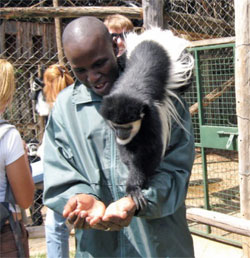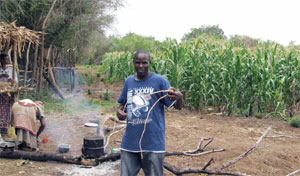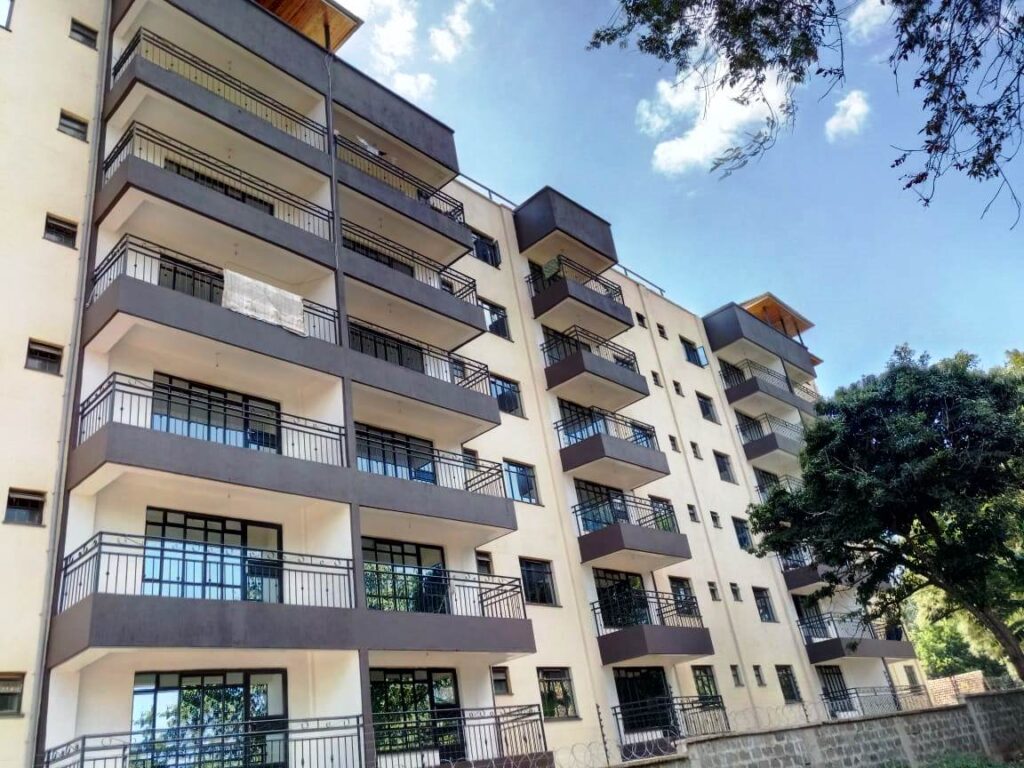By Maore Ithula
From a distance, the monkey perched on a tree branch on the edge of a forest strikes a majestic pose, its upper black colour resembling a crisp waistcoat that contrasts sharply with a lower, white abdomen.
Another primate, of a dull, grey hue stares back stubbornly from another branch. The beautiful monkey is the Tana River Colobus while the ugly species is the Tana River Mangabey.

Primate researcher Stanislaus Kivai with a red colobus monkey at a primate reserve in Tana River District
Many differences in appearance have been cited between the Tana River red colobus and the mangabey, but now a scary similarity stares at their future. They have both been listed highly an international index of rare animals facing extinction.The red colobus and the mangabey species only found in Kenya, in habitats in Tana River District, are now listed number 25 by the Convention on International Trade in Endangered Species (Cites).
The Institute of Primate Research (IPR) has sounded an alarm to call attention to the definite demise of the animals unless something is done to save them.
If the species disappear from the face of the earth, it will be the first time in recorded history of Cites that a dry land animal from Kenya will have gone into extinction.
An IPR research scientist Stanislaus Kivai, says besides human encroachment into the primates’ habitats in Tana River District, aggressive invasion by the Prosopis juliflora weed, also known as mathenge, pose a formidable challenge to the survival of the animals.
In a recent survey conducted by IPR to establish what escalates human and non human primate conflict in the area, Kivai found out that the primates stray out of the forests to look for food in farms because the prickly weeds have colonised their forest habitats destroying most plants which hitherto used to be their source of food.
There are about 80 forest patches along the River Tana where the two primates are found. Over time vegetation in the forests has been cleared by humans to give way to farming.
A study conducted in 1974 established that the type of red colobus and the mangabey monkeys in Tana River were unique and found nowhere else in the world.
Following this discovery the Tana River National Primate Reserve was established to conserve the animals, supervised by Kenya Wildlife Services (KWS). It is one of few conservancies established to protect primates in East Africa.
Human activities
National reserves are supervised by KWS but managed by County Councils. Minimal, but regulated human activities are allowed in these protected areas.
The primate reserve is located in the Mchelelo forest complex which comprises 25 forest patches within Gwano and Ndera locations, says Kivai. 
A resident of Tana River District shows a woven rope, the type that is used to trap monkeys invading farms. Photo: Maore Ithula/Standard
The reserve that covers about 11 square kilometres is home to 46 per cent of the entire population of Tana River red colobus monkeys and 54 per cent of the mangabey monkey.
However, despite the noble cause, the foundation of the reserve has been shrouded in controversy since it was established.
The Pokomo community who are the native to the area have been demanding compensation as initially agreed between them and the Government before the reserve land was excised.
The push and pull between the community and the KWS over the occupation of the forest was taken to the court in 1976.
In 2007 the High Court in Mombasa determined that the land belongs to the area residents and barred KWS from interfering with farming activities of the residents.
Nevertheless, KWS is staying put and conservation of the animals is still continuing albeit with resistance by locals, says Kivai.
A primate census conducted by IPR in 1994 established there were between 1,000 and 1,300 of both monkey species within the reserve. A repeat of the count in 2001 posted between 736 and 838 while the latest census carried out last year established a drop of between 33 and 36 per cent of the entire population of the animals.
Alarmed by the findings, the World Bank donated Sh500 million for the relocation of people living in the conservancy to Kipini, about 200km from Hola, the Tana River District headquarters, with attractive terms of compensation.
With more donor funding expected, IPR is involved in a new conservation approach where the Pokomo community is now taking part in the process.
Community programme
The programme is being managed by KWS and IPR in partnership with Rutgers University (USA) and the Northern Rangelands Trust, a local NGO.
He says: "In the new approach, we are running an interactive community conservation programme. With the help of community elders, we assist members of the Pokomo community to form conservation groups," says Kivai.
 The Standard Group Plc is a multi-media organization with investments in media platforms spanning newspaper print
operations, television, radio broadcasting, digital and online services. The Standard Group is recognized as a
leading multi-media house in Kenya with a key influence in matters of national and international interest.
The Standard Group Plc is a multi-media organization with investments in media platforms spanning newspaper print
operations, television, radio broadcasting, digital and online services. The Standard Group is recognized as a
leading multi-media house in Kenya with a key influence in matters of national and international interest.











